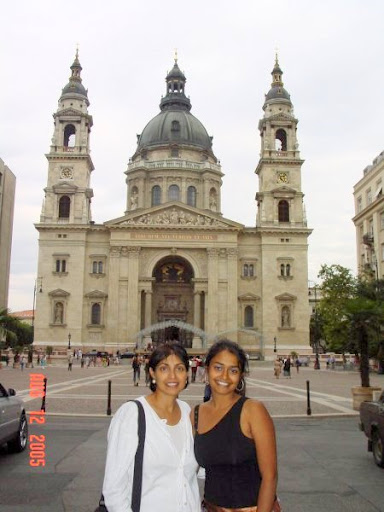Budapest
Twin Cities Astride the Danube
(On the windy roof of the Basilica of St. Stephen)
Leaving Austria regretfully behind us, Llew, Chriselle and I made our way by train into Budapest, capital city of Hungary.
For most of the journey, we followed the course of the Danube that glittered softly in the morning sunshine. As it twisted and bent its way over stubbled fields, I could see why it inspired one of the world’s most famous waltzes, thanks to the genius of Johanna Strauss. Mile after mile of extra-large sunflowers smiled benignly at us as we sped past and the lines of Robert Louis Stevenson’s poem, “From a Railway Carriage” came to my mind:
“Faster than fairies, faster than witches
Bridges and houses, hedges and ditches…”
Then, we were pulling into the bustling railway station and my reverie came to an end.
Straddling both banks of the River Danube, there is much to see and do in modern-day Budapest. Take the city at your own pace. The surfeit of grand cathedrals and palaces can overwhelm if one doesn’t pause for an occasional coffee or confection. Try Gerbaud’s, an 18th century Viennese style cafeteria that offers mouthwatering pastries served by pretty Hungarian women in black dresses, white aprons and pert frilly caps.
Pest’s Inner City or Belvaros comprises three monumental buildings—the Parliament House on the river bank, designed in imitation of London’s Houses of Parliament; the State Opera House and the Basilica of St. Stephen which contains relics of the monarch-saint.
Our guided tour in English of the Parliament House took us into the very center of Hungary’s political system and showed us the Crown Jewels. Of these, the one thousand year old Crown of St. Stephen is the country’s most prized possession. We also had a long pause in the ornate debating chamber. Everywhere we were stunned by the beauty of the interior decoration, the elaborate gilding on walls and columns, the vast number of statues of people who actually lived and of representations of Hungarians serving in various fields and professions.
Our visit to the Basilica of St. Stephen (above) was undertaken while a wedding was in progress. We also took the elevator to the dome to see views of the city which reminded us very much of the solidity of Central Bombay.
One of the most unique experiences we had in Budapest was joining the local folk to “take the waters” at the thermal spas for which the city is noted. The underground took us to the Szenchenyi Public Park where we bought tickets to enter the Public Baths in order to soak in the warm and soothing mineral waters. The experience was hugely foreign to us but deeply fascinating. As we kicked back in the vast pools together with Hungarians of every age, shape and size, we were also taken by the gorgeous building that houses the entrance to the baths. We would certainly recommend this rather unusual past time to anyone visiting Budapest. It is truly an experience you will not have anywhere else as you watch elderly men playing chess while waist-deep in warm water!
In Budapest, we ate bowl after bowl of delicious goulash, the paprika-spiced soup that is often made more hearty by the addition of beef, barley or beans. Street-side eateries serve the best kind and we did not hesitate to experiment. More satisfying and delicious to me, however, were the Stuffed Cabbage Rolls in Tomato Sauce that I ordered in a café in Buda. Yes, Buda, the other half of this capital city, is reached by bridges of which the most famous is the antiquated pedestrian Chain Bridge. Buda comprises mainly the Castle District from which height one can see the pretty Buda Hills and receive lovely views of the river and the city. While there, we visited Mattias Church, named after Good King Mattias who was married there and the Fisherman’s Bastion, a stone structure that offers sweeping views of the city. Hungarian souvenirs by way of embroidered skirts and blouses, wooden spoons, bowls, etc. were plentiful and Chriselle bought gifts for her friends from the friendly vendors scattered all around the Castle complex. We preferred Buda to Pest overall though the green parks of Margaret Island set right in the middle of the Danube, where our hotel was located, offered a very welcome refuge from the bustle of the metropolis.
Hungary is famous for its hand painted porcelain and our big buy on this trip was a tea set we purchased from Herend. The showroom was like a museum of priceless china and I had fun making selections, settling finally upon La Petite Rose, an 1820s design featuring tiny rose buds and green leaves on a white background, that once graced Hapsburg tables.
What struck us most about the Hungarians was their friendliness and their willingness to help. An elderly woman actually changed course from her own journey to help us find our way on a bus and a tram, all the while actively playing dumb charades with us! But for hotel and sales staff, no one speaks English in the former Eastern Bloc and communication was challenging but always fun.
We wish we could have spent more time in Budapest. Our lightning visit allowed us only an experimental foray into one of Europe’s most fascinating cultures. If all you have ever known about Hungary are paprika, goulah and Bela-Bartok, think again—this country has a great deal to offer and having been recently discovered by European tourist hordes, it is fast becoming a Mecca for the modern traveler.
Bon Voyage!

